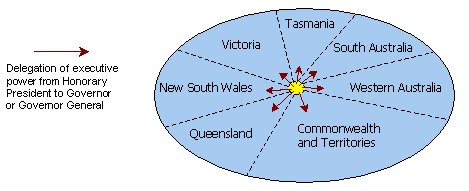
Senate Submission

Overview
Title
Introduction
Framework
Origins
Advantages

The Amendments
20 References
Section 126
Section 59
Section 60
Section 61
Section 2
Section 4
The States
All Amendments

The Election
Why Elect
Apolitical
Electoral Law
Timing

Independence
Introduction
The Two Roles
Costs v Benefits
Free Speech

Other Issues
Referendum
One Royal Link
Honorary Vice Pres
Spectrum of Powers
Questions
More Questions
Conclusion
| 1 |
| 3 |
Framework for an Australian Republic
The Honorary President Republican Model replaces the Crown with a Presidency and holds an Honorary President as the highest representative of that Presidency. The Presidency becomes a term meaning the whole of executive government in Australia.
The Federal Parliament and each state legislature shall consist of the Presidency and their upper and lower houses. In the case of Queensland, the legislature would consist of the Presidency and the Legislative Assembly.
The Honorary President holds a ceremonial position elected by the Australian people and represents the Presidency in accordance with the federal and state constitutions. Upon a nomination by the Prime Minister or Premier of a state, they appoint the Governor General and state governors and delegate executive power to these appointees in accordance with the constitution and laws of that jurisdiction.
Aside from this fundamental function, the Honorary President is prohibited from exercising any power of the Presidency directly. Their representation by the Governor General and Governors, means they have no business in any Parliament.

Above: The entire Presidency divided in seven jurisdictions
The Governor General and Governors represent not the Honorary President but the Presidency itself within the jurisdiction assigned by the federal constitution and otherwise by the geographic boundaries of the states. In this regard, the Presidency can be imagined as the entirety of executive power, with the Honorary President in the centre, divided into one federal and six state jurisdictions, each with its own Governor.
They appoint the Prime Minister and Premiers of the states, in accordance with the constitution and Westminster conventions. The Prime Minister and Premiers must continue to hold confidence of the lower house of Parliament. They sign legislation into law and continue their role as they performed it under the Queen.
The Honorary President, the Governor General and the six state Governors perform important civic and ceremonial functions. They can be patrons and sponsors of charitable and other worthwhile organisations.
The Governor General continues to be the commander-in-chief of the Armed Forces and continues to honour citizens with awards and decorations.
Unlike the Governor General, the Honorary President does not have an official residence in Canberra. They continue to live in the city or region of their choosing. The Honorary President has more discretion and capacity to support Australian business and interests overseas than the Governor General.

Above: Proposed Hierarchy of Executive Government
The Honorary President Republican Model continues to use the same hierarchical structure as in our existing system of government, the only substantial difference being the establishment of an office of Honorary President, based upon the powers and functions of the Queen. Like the Queen, the office of Honorary President is institutionally independent of the federal houses of parliament and the federal government in general. Part of that independence is in the appointment of Honorary Vice Presidents, who have no role in the system unless the serving Honorary President, resigns, is removed or dies in office.
The Honorary President can be removed using the same mechanism that Federal Court judges are removed. Apart from proved misbehaviour and incapacity, removal can occur if executive powers are exercised improperly, that is, without constitutional direction.
The framework described in this section results in a Unified Federal System, where the state parliaments remain peers of each other and peers of the Federal Parliament, and where the system of government for each jurisdiction remains comparable.